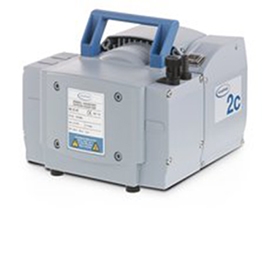Overview
Typical applications for chemistry diaphragm pumps include evacuating chemically aggressive gases and vapors from such equipment as rotary evaporators, vacuum drying cabinets and centrifugal concentrators. Chemistry diaphragm pumps from VACUUBRAND feature uncompromising chemistry designs. Their construction with fluoropolymers makes them very resistant to chemical vapors from inlet to exhaust and very tolerant to condensates. Our two-, three- and four-stage pumps also have a gas ballast valve that provides continuous purge with minimal impact on ultimate vacuum when working with condensable vapors. Pumping chambers are hermetically separated from the drive system ensuring long lifetimes of mechanical parts. Most importantly, diaphragm pumps are oil-free, for vastly reduced service demands compared with oil-sealed pumps. They eliminate the cost of water and its contamination well-known from water-jet aspirators, and the waste-oil disposal of rotary vane pumps.
Details
Chemistry diaphragm pumps, chemistry vacuum systems and chemistry pumping units
Our chemistry diaphragm pumps are available in a full range of volume flow rates and ultimate vacuum options. Single-stage models reach as much as 70 mbar (absolute) vacuum. Connecting pump heads in series as two-, three- or four-stage pumps improves an ultimate vacuum to as much as 0.6 mbar. Connecting heads in parallel provides higher flow rates. Our line offers combinations that satisfy virtually any laboratory need.
Nomenclature for VACUUBRAND pumps is built from the following codes designating specific features or components:
M = diaphragm (membrane) pump
E, Z, D, V = number of pump stages
E = single stage, up to 70 mbar
Z = two stages, up to 7 mbar
D = three stages, up to 1.5 mbar
V = four stage, up to 0.6 mbar
C = chemistry design, with fluoropolymerflowpath
NT = labels the series of pumps comprising the New Technology
AK = separator catchpot for inlet or outlet condensates, collects particles and droplets, keeps condensate in vacuum line from flowing into the pump, protecting pump performance and providing additional noise reduction on the pressure side
EK = exhaust vapor (emission) condenser for nearly 100 % solvent recovery in compact design, protecting environment and lab air
TE = dry ice or water ice cooled emission condenser for solvent recovery
PC = "Pumping Unit, Chemistry" - a chemistry pump with vacuum control and solvent recovery
Chemistry vacuum system = a chemistry pump with accessories like inlet catchpot and/or solvent recovery
Chemistry pumping unit = a chemistry vacuum system with vacuum control and solvent recovery
SYNCHRO = pumping unit for simultaneous operation of two independent vacuum applications by a single pump
VACUUBRAND offers chemistry vacuum systems and chemistry pumping units as complete ready-to-connect systems with the best chemistry diaphragm pumps for the desired vacuum range and volume flow rate. You can maximize the vacuum application's efficiency, functioning and environmental protection with the right combination of coordinated accessories. The basic pumps of the different system families are mounted in a space-saving portable system and equipped with the accessories appropriate for particular applications.
The components
AK - (as shown) the separator catchpot for inlet or outlet-side condensates. The inlet (suction-side) separator catchpot collects particles and droplets of liquid. An exhaust (pressure-side) separator collects outlet condensate, keeps condensate from returning to the pump and helps keep the pump whisper quiet.
EK - (as shown) the emission condenser for capturing vapors from the exhaust side of the pump. Made of shielded glass, it is compact, but still highly efficient. It allows for virtually 100% recovery of solvents and protection of the atmosphere.
EK Peltronic® - an electronic emission condenser that operates without cooling water or dry ice.Peltier elements and air cooling afford clean, convenient refrigeration.
TE - a condenser for dry ice or water ice for emissions control and solvent recovery without cooling water supply.
Liquid level sensor: Keeps the collecting catchpots (at AK or EK) from overflowing; supplies warning signals via the electronic vacuum controller with VACUU·BUS® connections, and stops the pumping process if needed.
Manometer: A mechanical vacuum manometer provides trend indication, and approximate vacuum levels on some of our more basic models.
- MZ 2C NT +AK+M+D
- PC 101 NT
- PC 201 NT
Two vacuum connections on one pumping unit: We have systems and pumping units with a second vacuum connection available for independently operating two processes in parallel with just one pump. Check valves reliably isolate the two different applications from one another.
Manual flow-control regulation: The flow-control valve is designed for easy adjustment of the effective volume flow rate, and mounted on the inlet separator on some pumping units










